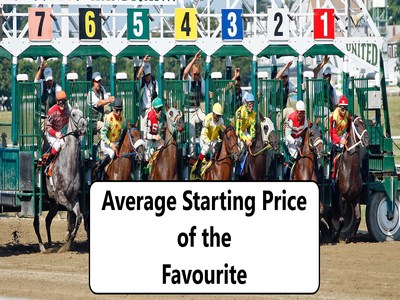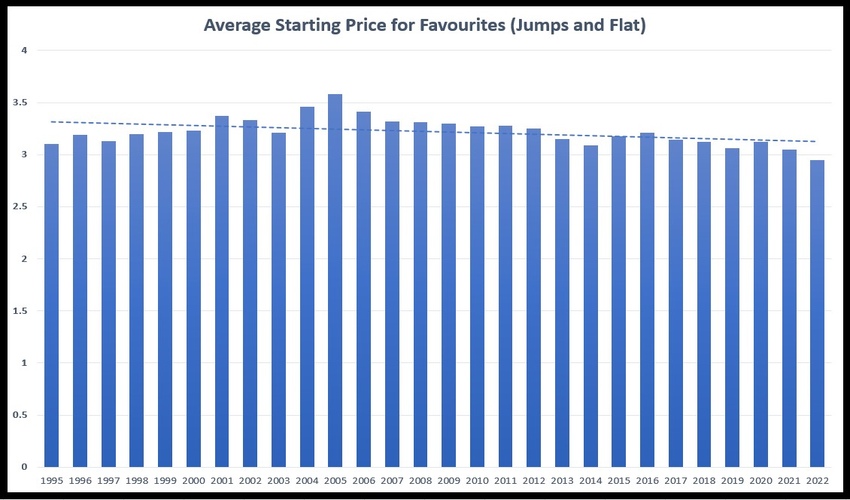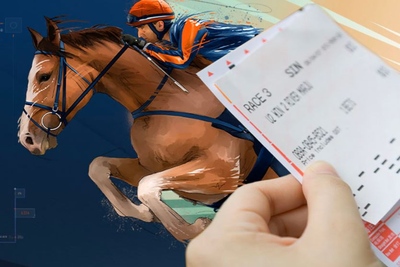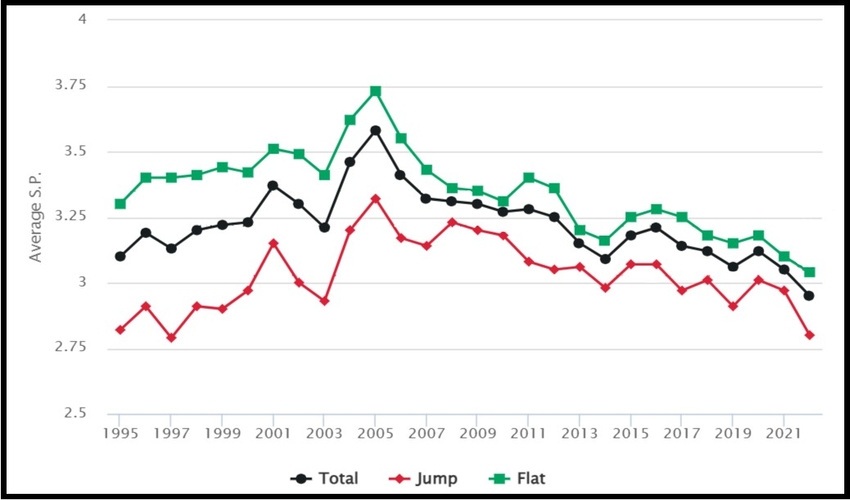 Some people think betting on the favourite is a waste of time, others have no doubt tried betting strategies using the favourite as their starting point, but if you look at any meeting on the racing calendar, the favourites do attract a large proportion of the wagers.
Some people think betting on the favourite is a waste of time, others have no doubt tried betting strategies using the favourite as their starting point, but if you look at any meeting on the racing calendar, the favourites do attract a large proportion of the wagers.
Now, depending on the type of race, how many runners there are, and exactly which horses are taking part, the odds for the favourite can be as long as 5/1 and as short as 1/10, or even further in either direction.
That’s a big difference, so I thought it would be interesting to investigate what the average starting price of favourites in UK horse racing is, and how it has changed over time.
The BHA keep this sort of information so the stats I’m talking about are the official figures, and what you can see from them is a slow but steady drop in the average starting price for favourites over the last 20 years.
The gap between the average starting price for favourites in flat racing and jump racing has narrowed too.
I’ll explore these things in more detail below.
Average Starting Price for Favourites is Getting Shorter

Since the British Horse Racing Authority started keeping records in 1995, the overall average for starting prices of the favourite reached a peak of 3.58 (13/5) in 2005.
However, as of 2022, that number is at its lowest ever price of 2.95 (about 2/1), and it has been steadily dropping for decades.
If you look at the chart above you can clearly see the long-term trend line tipping downwards.
So what is the reason for this?
Well, it isn’t because bookies are increasing their margin. As I explored in this article, the bookies have actually dropped their margins over time to remain competitive, so we can’t blame them for being greedy.
They are, however, being much more cautious.
Something else that has happened over this time period is the development of new data driven technology and software, which can help bookmakers draw up much more accurate odds
You can see it in action by looking at this table:
| Year | Total SP | Jumps SP | Flat SP |
|---|---|---|---|
| 2022 | 2.95 | 2.8 | 3.04 |
| 2021 | 3.05 | 2.97 | 3.1 |
| 2020 | 3.12 | 3.01 | 3.18 |
| 2019 | 3.06 | 2.91 | 3.15 |
| 2018 | 3.12 | 3.01 | 3.18 |
| 2017 | 3.14 | 2.97 | 3.25 |
| 2016 | 3.21 | 3.07 | 3.28 |
| 2015 | 3.18 | 3.07 | 3.25 |
| 2014 | 3.09 | 2.98 | 3.16 |
| 2013 | 3.15 | 3.06 | 3.2 |
| 2012 | 3.25 | 3.05 | 3.36 |
| 2011 | 3.28 | 3.08 | 3.4 |
| 2010 | 3.27 | 3.18 | 3.31 |
| 2009 | 3.3 | 3.2 | 3.35 |
| 2008 | 3.31 | 3.23 | 3.36 |
| 2007 | 3.32 | 3.14 | 3.43 |
| 2006 | 3.41 | 3.17 | 3.55 |
| 2005 | 3.58 | 3.32 | 3.73 |
| 2004 | 3.46 | 3.2 | 3.62 |
| 2003 | 3.21 | 2.93 | 3.41 |
| 2002 | 3.3 | 3 | 3.49 |
| 2001 | 3.37 | 3.15 | 3.51 |
| 2000 | 3.23 | 2.97 | 3.42 |
| 1999 | 3.22 | 2.9 | 3.44 |
| 1998 | 3.2 | 2.91 | 3.41 |
| 1997 | 3.13 | 2.79 | 3.4 |
| 1996 | 3.19 | 2.91 | 3.4 |
| 1995 | 3.1 | 2.82 | 3.3 |
As we hit the mid-2000s when internet betting started to take off, and software companies began to develop and improve their fancy programs for compiling odds, the average starting price for favourites began to decline.
However, while this may be an influencing factor, it can’t be the whole picture, because although it’s true that the bookmakers set the prices to begin with, its what the market does afterwards that largely dictates how the price moves.
Punters Pushing the SP Shorter
 As you probably know, if a bookmaker takes too much money on the favourite they will shorten the odds to make it a less attractive proposition and hopefully attract bets on longer priced horses to balance their books.
As you probably know, if a bookmaker takes too much money on the favourite they will shorten the odds to make it a less attractive proposition and hopefully attract bets on longer priced horses to balance their books.
Therefore, if the starting price for the favourite is getting shorter over time, it means that more punters are backing it more often.
There may be a few different reasons for this, but after studying a lot of gambling industry data I believe that gamblers are becoming less patient, especially those who are inexperienced. Punters who don’t have the patience to properly study form or look for value bets are much more likely to just bung a fiver on the favourite.
Slightly contradictory to this, I would also say that in the same way the bookies have access to more detailed information these days, so do the punters.
The internet gives us instant access to professional advice and tips, highly detailed data on form and progeny, as well as news and interest pieces that can hype a horse up.
This makes punters better informed than ever, and those who do put a bit of effort in before placing their bets may well find that the favourite is actually their favourite too, and if they catch it before the price shortens too much, may well decide to go for it, pushing the SP down with every bet made.
Why is the Average Starting Price Better for Flat Racing than Jumps?

Although the data for flat and jump racing follows a very similar pattern over the years, as you can see in the chart above, the odds for favourites in flat racing are higher.
The gap between the two has closed as time has gone on, from a 17% difference in 1995 to an 8.5% difference in 2022, but still, that difference is consistent.
The simple reason for that, is because favourites over fences and hurdles tend to win more often than favourites on the flat, so of course, this will be reflected in the starting price.
The availability of data on the horses is a factor here too though.
Horses that race over jumps tend to be older than those who race on the flat, so there is much more form to study and bookies can get a clearer picture of which horses might do well given their previous performances at the track in question, and their recent runs.
This allows them to start things off at a more accurate place, with the market moving the price from there onwards.
Plus, jumps races tend to have smaller fields, and there is no draw bias to consider like there is with flat racing.
A lot of the really big meetings on the racing calendar, like Cheltenham Festival, are jumps meetings too, and these draw huge interest from bettors. It’s more important than ever for bookies to balance their books on these days because such a lot of money is staked on the favourites, meaning an awful lot more risk for the bookie.
Obviously then, the odds on the favourites will be shorter in these situations, bringing down the overall average.
Is Betting on the Favourite a Good Idea?
 This is a question that should be asked for each individual race rather than in this broader context. It’s certainly not a bad idea, not always anyway, but then that doesn’t necessarily make it a good idea either.
This is a question that should be asked for each individual race rather than in this broader context. It’s certainly not a bad idea, not always anyway, but then that doesn’t necessarily make it a good idea either.
It all depends on the horse and race in question, which other horses are running, and the research you have done.
On top of this, there are favourites and then there are favourites, you can’t really talk about ‘the favourite’ as though they are all one and the same.
For instance, statistics tell us that horses priced at 1.25 (1/4) or shorter win 86% of their races, and this is backed up by quite a famous study, albeit quite an old one, that showed the shorter the odds of a horse the closer they usually are to the true odds.
So put plainly, an odds on favourite is much more likely to be priced accurately than an odds against favourite, and long odds horses that aren’t favourites at all are less likely to be priced as accurately.
This is why you can usually find better value from longer odds horses, and why odds on favourites only win around 55%-60% of the time in the UK (that’s on the flat, it’ higher for jumps).
How often do you see a handful of horses in a large field all with the same odds, say 10/1? Do they really all have exactly the same chance of winning? Probably not. The price just isn’t as accurate.
Don’t get confused between the odds on favourite and the stats for favourites in general though. If you look at the chances of any favourite winning, regardless of the odds or the racing discipline, it’s much lower at around 33%.
Betting on the favourite all the time is certainly going to lose you money in the long run then, but brushing the favourite off as a pointless bet can also leave money on the table, so it really needs to be judged on a case by case basis.
Obviously, if something is priced at 1/20 it’s probably not worth your time, but those priced around evens or better could be worth a bet – but only after you have done your research and drawn your own conclusions about their chances of winning.
